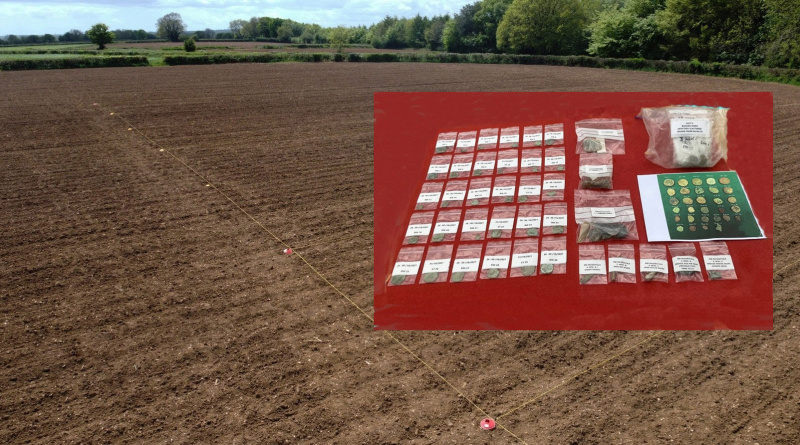“Happy Days” – finding a Roman hoard
By Richard Wells
Finding the hoard – Part 1
Late last October, I was detecting a permission off the A30 overlooking our Devon village. The route follows, broadly, a physical ridge taking trade and tourism to southerly Exeter and to Cornwall beyond.
Not hopeful
In approaching the afternoon, I was less than optimistic. The stout stalks of wheat stubble were still fresh and unbending and although I had turned up this small Bronze Age axe head near the entrance to the field some eighteen months ago, a couple of later visits had suggested that the area was at best “quiet”.

Photo: Richard Wells
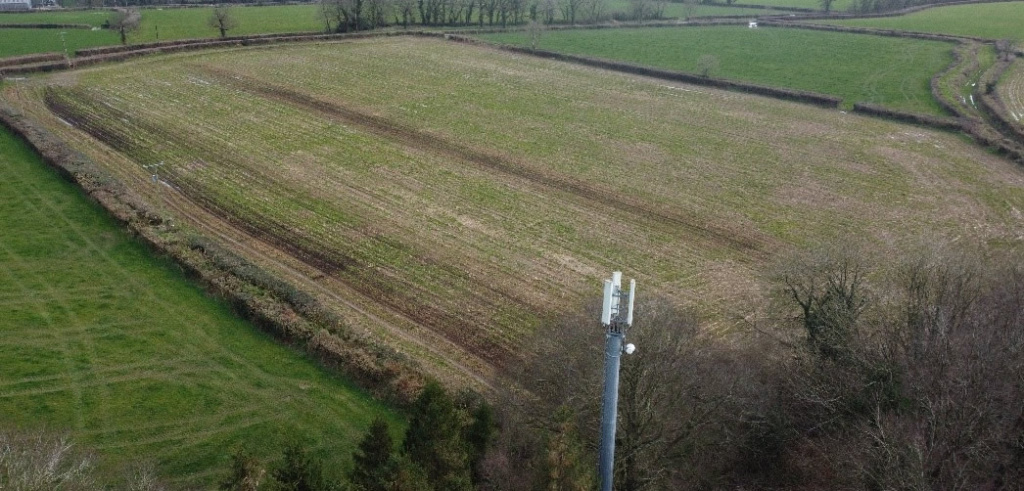
Photo: James Wells
Hopefulness was further reduced as the field is overlooked by a radio mast with emissions from which my normally reliable Equinox 800 has difficulty coping. Preferring to search in “multi-frequency”, here I was limited to 40 Khz – the only bandwidth which could deal with the electro-magnetic chatter.
A clear signal
Ten minutes in, I dug a clear signal with a TID of 15. It was a heavy early Roman bronze – a Dupondius or Sestertius – and I logged the find spot with a ten-figure grid reference, my usual practice for anything emerging of likely historic interest.

Photo: Richard Wells
Minutes later, three more similar came out and moments later a couple of fragments which, but for the context of the full coins, might easily have been overlooked as scrap. Those positions were also logged. By close of play, a total of twelve had turned up in an area of some 25 square metres.
Following days, with friends
I resolved to come back for a full session the following day and invited a couple of club friends to help, one of them a Deus user to see if his machine could cope better with the EMI. It did.

Photo: Richard Wells
Over three days, thirty coins or recognisable part coins turned up, this time in an expanded area of some fifty square metres, all of a similar age and all of them in very poor condition, with barely a bust or reverse discernible.
No attempt was made to clean them in any way, no rubbing or brushing; I just bagged them up, soil traces and all and declared the finds to Dr Lucy Shipley, our FLO. She in turn wrote to our District Coroner, reporting the find and asking for permission to retain the present finds, bagged and labelled, pending a re-search of the field in Spring after it had been freshly ploughed.
Finding the hoard – Part 2
Fast forward to May of this year. The farmer-owner of the land had been regularly updated both by the FLO and myself and he phoned one morning to say that the field had been re-ploughed, harrowed and drilled with a fresh crop of maize. I contacted members of our East Devon club and on a chosen Sunday, seven of them with assorted detectors turned up to do battle.
Organising the search
Familiar with the difficulty of herding cats or detectorists, and wanting something akin to a scientific search pattern, I devised a plan.
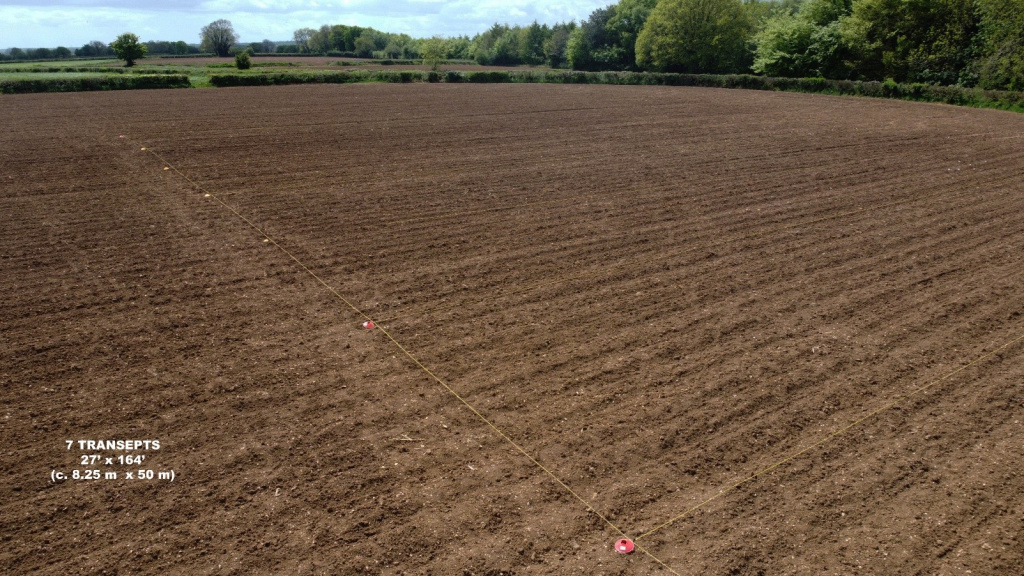
Photo: James Wells
I assessed the likely area of scatter and, the evening before the exercise, tested our marriage of fifty three years by asking Patsy, my wife, to join me in laying out seven transepts or lanes with bright yellow pegged cord , each some eight metres by fifty.
These dimensions, I thought, would give a decent detectable area if done in both directions and as slowly as individual style allowed. All seven members were good, proven detectorists.
Magnificent Seven
On the Sunday, the Magnificent Seven drew lots for a transept and agreed that, having searched his lane up and back, would then swap with a colleague with a different machine, who would search the same transept. A coin find was to be announced with a shout and a bright yellow peg put in at the findspot. I did no detecting myself, just co-ordinated the group effort.
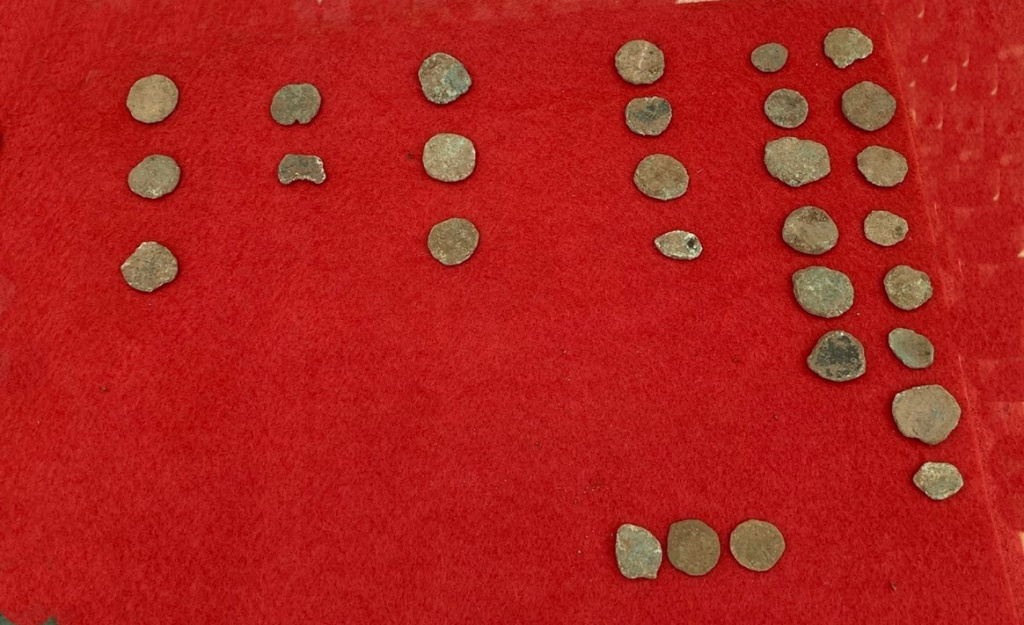
Photo: Richard Wells
After only a few moments of searching, the first shout went up and then they came in thick and fast.
At the end of the morning, and after a good bit of lane-swapping, 29 more coins had been unearthed, bringing the total scatter to 59.
Send up the drone
Our son James drove down for a second time from Derbyshire with his licensed drone because we wanted more aerial views, including the scatter, if we could. In anticipation of his arrival, I had placed more yellow pegs from the October finds, using the October recorded co-ordinates and adding to those of the previous day’s re-search of the site.
The photography proved more difficult than we had at first expected because the height required to give an overview of the field clashed with the visibility of the distributed pegs. Though clearly making an impressive cluster when viewed from ground level, the 59 yellow pegs simply didn’t show up when photographed from 250 feet.
Now we’re cooking
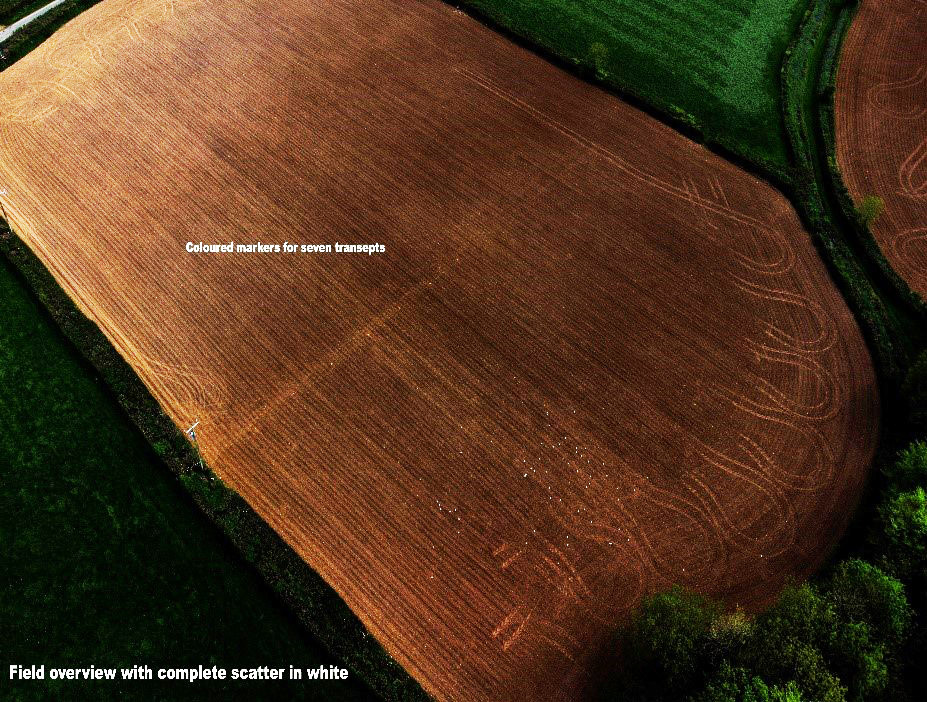
An impromptu solution was found over a lunch-break by raiding Patsy’s baking cupboards and finding 59 grease-proof cake circles, each 9” in diameter. With its yellow peg though the centre of each, these then allowed the drone to capture them with fascinating effect.
Finds
Of the total seven ‘lanes’ covering the estimated area of scatter, Transept 1 produced no finds at all and Transept 7 produced just one. Nor was anything found beyond Transept 7, suggesting that the estimation had been fairly accurate.



Incidental to the coin finds, a number of other potentially interesting items turned up for consideration by the PAS, not least some worked lithics which suggest footfall long before our Romans.
Treasure inquest
The individual coins are now all bagged up with finder reference and transept indicator shown and deposited with the FLO pending Coroner’s inquest.

I have asked the Coroner to list the team of seven as “assisting” in the hoard discovery.
Moral of the story
And the moral of this story…. In experiencing a “quiet” field, it may just be that we’re not listening…
Happy Days!

